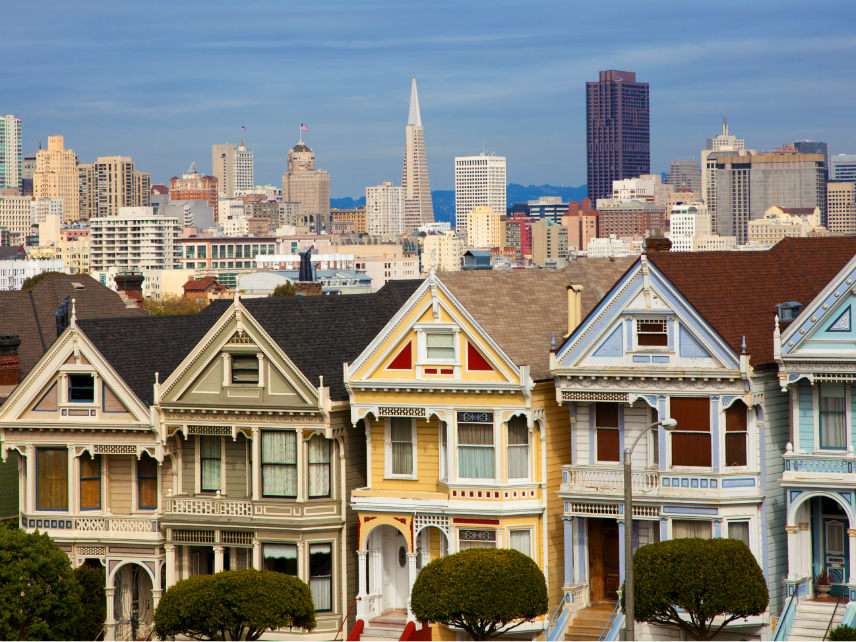81 Percent of Homes in the San Francisco Metro Area Are Worth More Than $1 Million. That's Not Normal.
Restrictions on the supply of new housing are making California's cities increasingly unaffordable.

There are a number of ways to measure California's housing crisis, from looking at the percentage of renters paying over 50 percent of their income in rent (28 percent) to where the state falls in housing per capita (49th). Yet another data point to include on the roster is the number of homes in the state that are worth over $1 million dollars.
Last week, real estate listing company Trulia released a new report which looks at the number of $1 million residential properties in each city, finding that California cities have by far the largest percentage of seven-figure homes in the nation.
"Of the more than 15,100 larger neighborhoods nationwide included in this analysis, 838 had a median home value of $1,000,000 or more, roughly two-thirds of which are in California," writes Felipe Chacón, the report's author.
San Francisco, perhaps unsurprisingly, leads the pack with a whopping 67 percent of homes valued at over $1 million. When you zoom out to look at the San Francisco metro-area—which includes a number of wealthier suburbs not in city limits—that number jumps to a full 81 percent. The estimated median home value in the Bay City is $1.3 million.
The runners up? The Bay Area cities of Oakland and San Jose, with 30 and 70 percent of homes in their metro areas priced in the seven-figure range.
Of the top ten metro areas with the largest percentage of $1 million homes, seven are in California.
The non-California cities in the top ten are Honolulu (where 20 percent of homes are worth upward of a $1 million), Seattle (13 percent), and Long Island in New York (10 percent).
Across the U.S. writ large, only 3 percent of homes are worth more than $1 million.
To be sure, the rise in home prices is a national trend, with very few metro areas seeing prices stay flat or decline according to the Trulia. Yet, that California is so far out ahead of the pack suggests something is off with land use in the Golden State.
One explanation is that California cities have placed severe constraints on building new housing, says Michael Manville, an associate professor of urban planning at University of California Los Angeles.
"The hallmark of a housing crisis is not that your new housing is expensive. New housing has always been more expensive than existing housing. The hallmark of a housing crisis is when a junky looking bungalow in Venice costs $1 million dollars that was built in 1985," Manville tells Reason.
That is hardly an exaggeration. Back in April, a burned down shack in San Jose went on the market at $800,000, and sold for over $900,000 a few days later.
"That can only happen when there is an absence of supply to match an increase in demand," Manville says. "The reason we have this, of course, is that for a variety of reasons we don't allow enough new housing to sort of contain this price appreciation."
Indeed, in Los Angeles, over 75 percent of the city is zoned for only single-family homes or duplexes, according to Curbed. Something like 75 percent of San Jose is also single-family housing. In San Francisco, single-family homes make up 30 percent of the city's housing stock, but take up some 60 percent of the city's land.
Making matters worse are lengthy permitting approval processes for new construction that can stretch out the delivery of projects by years. The more units of housing a project adds, the longer it will typically take to get through this process.
On top of all of this is a system of taxation—ushered in by California's famous/infamous Proposition 13—which puts strict limits on local governments' abilities to increase property taxes. As much as libertarians might like that, an unintended side effect is that local governments go hunting for new revenue elsewhere, often settling on imposing fees on new construction.
According to work done by the University of California Berkeley's Terner Center, per-unit fees on new construction in California hover around $20,000, or three times the national average.
This further disincentivizes home construction, and raises the property values of existing homes even more.
It also creates a toxic political economy whereby local governments and home owners are incentivized to support existing laws limiting new development.
For homeowners, the logic is pretty clear: new housing supply would reduce the value of their property, thus they are more likely to oppose new development.
For cities, it's a little more complicated.
Constrained in their ability to raise property taxes, city governments try to shift the burden of providing public services onto developers.
Sometimes, as mentioned, that's through direct fees. Other times, local governments get their pound of flesh by conditioning project approval on the developer agreeing to build a park, repave streets, or reserve space in their planned building for community purposes.
If cities let go of their ability to shoot down new developments, says Manville, they also let go of their ability to extract concessions from developers.
Rent Free is a weekly newsletter from Christian Britschgi on urbanism and the fight for less regulation, more housing, more property rights, and more freedom in America's cities.




Show Comments (39)